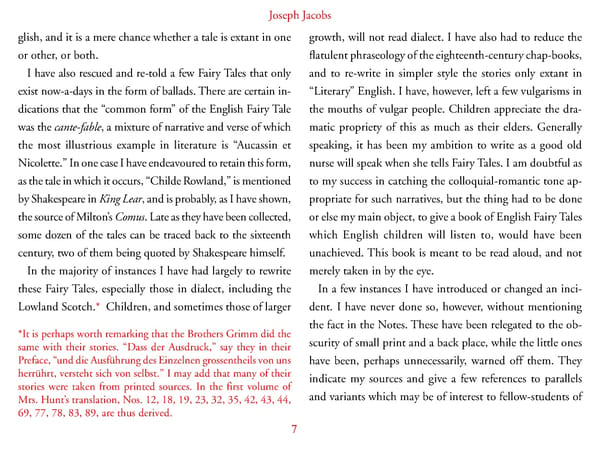7 Joseph Jacobs glish, and it is a mere chance whether a tale is extant in one or other, or both. I have also rescued and re-told a few Fairy Tales that only exist now-a-days in the form of ballads. There are certain in- dications that the “common form” of the English Fairy Tale was the cante-fable , a mixture of narrative and verse of which the most illustrious example in literature is “Aucassin et Nicolette.” In one case I have endeavoured to retain this form, as the tale in which it occurs, “Childe Rowland,” is mentioned by Shakespeare in King Lear , and is probably, as I have shown, the source of Milton’s Comus . Late as they have been collected, some dozen of the tales can be traced back to the sixteenth century, two of them being quoted by Shakespeare himself. In the majority of instances I have had largely to rewrite these Fairy Tales, especially those in dialect, including the Lowland Scotch. * Children, and sometimes those of larger growth, will not read dialect. I have also had to reduce the flatulent phraseology of the eighteenth-century chap-books, and to re-write in simpler style the stories only extant in “Literary” English. I have, however, left a few vulgarisms in the mouths of vulgar people. Children appreciate the dra- matic propriety of this as much as their elders. Generally speaking, it has been my ambition to write as a good old nurse will speak when she tells Fairy Tales. I am doubtful as to my success in catching the colloquial-romantic tone ap- propriate for such narratives, but the thing had to be done or else my main object, to give a book of English Fairy Tales which English children will listen to, would have been unachieved. This book is meant to be read aloud, and not merely taken in by the eye. In a few instances I have introduced or changed an inci- dent. I have never done so, however, without mentioning the fact in the Notes. These have been relegated to the ob- scurity of small print and a back place, while the little ones have been, perhaps unnecessarily, warned off them. They indicate my sources and give a few references to parallels and variants which may be of interest to fellow-students of *It is perhaps worth remarking that the Brothers Grimm did the same with their stories. “Dass der Ausdruck,” say they in their Preface, “und die Ausführung des Einzelnen grossentheils von uns herrührt, versteht sich von selbst.” I may add that many of their stories were taken from printed sources. In the first volume of Mrs. Hunt’s translation, Nos. 12, 18, 19, 23, 32, 35, 42, 43, 44, 69, 77, 78, 83, 89, are thus derived.
 English Fairy Tales Collected by Joseph Page 6 Page 8
English Fairy Tales Collected by Joseph Page 6 Page 8